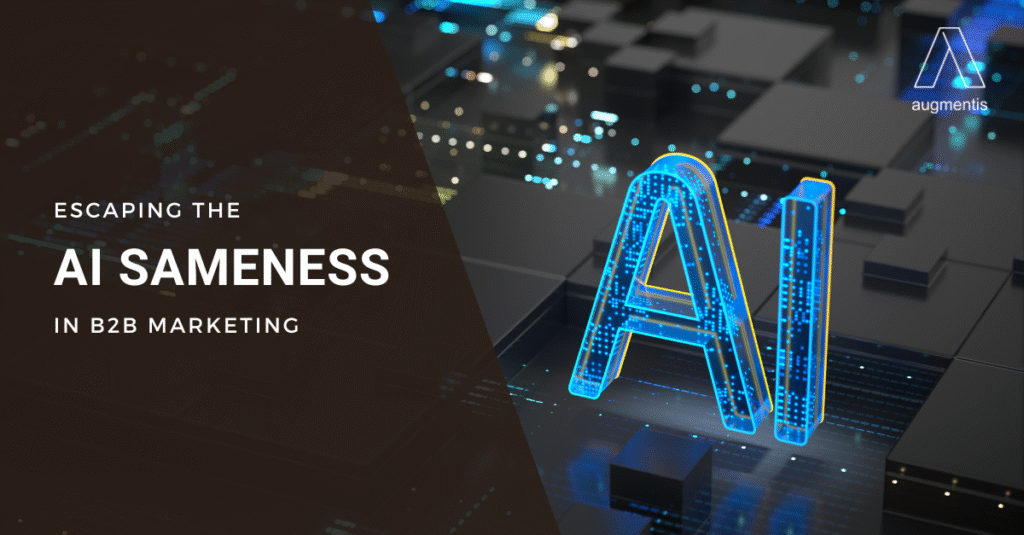
The proliferation of AI has made everyone a content writer. The same colleague who struggled to write a coherent email earlier now proudly flaunts “seasoned content writer” on their resume.
This modus operandi is most visible in B2B organisations across industries. Teams feed prompts into tools like ChatGPT, churn out “content” before the Maggi cooks, publish the same material across every channel, and then pat themselves on the back for a calendar full of assets. Downloads climb, yet tangible hot leads remain nowhere on the horizon.
That is the typical problem of AI sameness in B2B marketing. When organisations treat content as a commodity, they get volume but not velocity in deals.
What separates winners from copycats is a distinctive, compelling narrative. Skilled B2B marketers reframe the industry problem, make the stakes explicit, and align buying committees with tailored value propositions so that every asset nudges deals forward.
This is where a “Category Narrative” comes into the picture. Let’s unpack what it really means and why it beats any “content factory” hands down.
Table of Contents
What is a Category Narrative in B2B Marketing
In B2B marketing, a category narrative is a strategic storytelling framework that defines, inspires, and shapes an entire market category rather than focusing narrowly on a single B2B brand’s identity.
It positions your B2B company as the visionary guide or creator of that category by crafting a compelling, overarching story that resonates with customers, stakeholders, and employees alike.
Fundamentally, a category narrative addresses four key elements:
1. The Desired Change
It articulates the shift in behaviour, mindset, or practices the market needs to embrace to unlock new possibilities.
2. The Obstacles
It highlights the current pain points, frustrations, or inefficiencies that keep the status quo in place and block progress.
3. The Path Forward
It outlines the B2B decisions, actions, or innovations required to overcome those challenges and drive meaningful transformation.
4. Your Brand’s Role
It integrates your solution as the essential catalyst or enabler within this larger evolution and explains why the timing matters now.
This approach is especially powerful for disruptive innovators because it creates demand for the category itself while placing your B2B brand at the forefront of the conversation.
The importance of this becomes clear when observing a B2B buying committee in action. Members come with varying incentives, information, and levels of risk tolerance. A category narrative provides a shared framework, enabling everyone involved in the decision-making process to assess your idea against a single standard. Without that framework, content must work harder to bridge differences one meeting at a time, and it rarely keeps pace.
AI Content Factory versus Narrative Engine
AI content factories produce volume. They generate hundreds of blog posts, eBooks, white papers, case studies, emails, and social posts. All are polished enough to feel professional and all are perfectly forgettable.
While scale can be useful, it is also deceptive. A factory approach tends to produce assets that sound sufficiently similar to be interchangeable. The cumulative effect is noise.
A narrative engine is different. It uses the same creative resources and perhaps the same number of assets, but each piece is deliberately designed to play a distinct role in a clearly mapped journey.
Web pages introduce the story, sales decks equip internal stakeholders to share it, white papers address technical due diligence, and webinars spark conversion moments. Together, these pieces form a connected narrative instead of a random collection of content. This cohesion builds influence that moves across different B2B buyer roles and accelerates the path to a decision.
If you compare the two approaches side by side, the assets may look similar at first glance. Beneath the surface, however, the narrative engine includes cross-asset references, recurring metaphors, and a defined set of trade-offs that drive real choices. The factory produces options, while the engine produces direction. This difference becomes clear in pipeline conversion and in the type of prospects who choose to engage.
How to Launch a Narrative Engine without Becoming a Content Factory
1. Start with research. Spend time in discovery calls, customer workshops, and product debriefs. Build a single page narrative brief that everyone can reference and repeat.
2. Lock the frame. Commit to a single positioning choice per campaign and avoid any expansion that weakens the story or introduces vague additions.
3. Build stakeholder toolkits before content. Prioritise making the story usable inside accounts with talk tracks, objection handling, and concise internal explainers.
4. Run focused pilots. Test the narrative in a small set of accounts and gather qualitative feedback from both supporters and sceptics across roles.
5. Iterate. Use real feedback to refine metaphors, adjust trade-offs, clarify language, and update the toolkit before you scale production.
The aim is to move from plausible prose to persuasive practice. That requires discipline, not just volume.
Summing Up
AI will continue to produce readable content, but in the complex world of B2B marketing, content without a narrative is just noise. It is wallpaper that blends in with everything else. True B2B growth will not come from more content; it will come from a strong category narrative that acts as your competitive advantage by aligning teams, clarifying decisions, and focusing effort where it matters.
Here is the truth: ignoring the power of a unique narrative will leave you in the blind alley of AI sameness. You can either keep running a content factory and get lost in the crowd, or you can build a narrative engine that equips your internal B2B stakeholders, maps your story to every asset, and drives real, repeatable growth.
Reach out to us at marketing@augmentis.in to discuss how you can build a sustainable narrative engine that truly cuts through the noise and turns consistent messaging into measurable pipeline.

